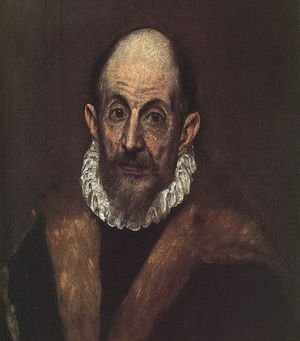Difference between revisions of "El Greco"
(Changed category) |
|||
| (10 intermediate revisions by 3 users not shown) | |||
| Line 1: | Line 1: | ||
[[Image:A_View_of_Toledo.jpg|thumb|500px|A View of Toledo, one of El Greco's most famous paintings.]] | [[Image:A_View_of_Toledo.jpg|thumb|500px|A View of Toledo, one of El Greco's most famous paintings.]] | ||
[[File:El Greco considered Self Portrait 1604.jpg|thumb|left|Considered Self-Portrait, 1604.]] | [[File:El Greco considered Self Portrait 1604.jpg|thumb|left|Considered Self-Portrait, 1604.]] | ||
| − | '''Doménicos Theotokópoulos''' (Greek: Δομήνικος Θεοτοκόπουλος) known as '''El Greco''' (''The Greek'' in Spanish) was born in [[Crete]] in 1541, and died in 1614. He was a [[painter]], [[sculptor]], and [[architect]]. | + | '''Doménicos Theotokópoulos''' (Greek: Δομήνικος Θεοτοκόπουλος) known as '''El Greco''' (''The Greek'' in Spanish) was born in [[Crete]] in 1541, and died in 1614. He was a Mannerist [[painter]], [[sculptor]], and [[architect]] of the Spanish [[Renaissance]]. In 1560, he went to Venice, [[Italy]], where [[Titian]] became his greatest mentor; he also had the influence of [[Tintoretto]] and [[Michelangelo]]. From Venice, El Greco moved to [[Rome]], where he worked from 1570 to 1576. In Rome, El Greco admired Parmigianino who could gave him the inspiration for his stylized figures. Around 1576, he settled in Toledo [[Spain]] and was considered the first great genius of the Spanish School. Some of his [[painting]]s are regarded as the most vivid works in the world. |
| + | Curiously, the paintings of his Italian period were very different in style from his later works. Some of the first are ''Christ Healing the Blind Man'' (1560s), ''The Annunciation'' (1570-1575), and ''Christ Driving the Traders from the Temple'' (c. 1570)... Man of eccentric habits and ideas, of tremendous determination, extraordinary reticence, and extreme devoutness’ he was valued and respected by the intellectuals of Toledo. [http://www.abcgallery.com/E/elgreco/elgrecobio.html] He excelled also as a portraitist. | ||
| + | |||
| + | ''The Burial of the Count of Orgaz'' (1586 - 1588) is considered to be his best-known work. It ''is central to our understanding of El Greco because it encapsulates the object of his art, which is to suggest a visionary experience—something that is not an extension of our physical world but of our imaginative faculties; '' [http://www.metmuseum.org/toah/hd/grec/hd_grec.htm] the success of this painting brought him a great number of commissions from the Church. | ||
| + | |||
| + | El Greco did not have followers, and his art was forgotten for many years. At present he is regarded as one of the most important representatives of European Mannerism. | ||
{{Clear}} | {{Clear}} | ||
| + | |||
== Petite Gallery == | == Petite Gallery == | ||
| − | |||
<gallery> | <gallery> | ||
Image:El Greco Magdalena.jpg|St. Mary Magdalen in Penitence | Image:El Greco Magdalena.jpg|St. Mary Magdalen in Penitence | ||
| Line 15: | Line 20: | ||
File:El Greco La Crucifixión, Doña María de Aragón ca.1600.jpg|Crucifixion | File:El Greco La Crucifixión, Doña María de Aragón ca.1600.jpg|Crucifixion | ||
File:El Greco. Portrait of a Nobleman with His Hand on His Chest.jpg|Portrait of a Nobleman with His Hand on His Chest | File:El Greco. Portrait of a Nobleman with His Hand on His Chest.jpg|Portrait of a Nobleman with His Hand on His Chest | ||
| + | File:El Greco Cristo en la cruz adorado por dos donadores.jpg|Christ in the cross adored by two donors. | ||
</gallery> | </gallery> | ||
== See also == | == See also == | ||
| − | + | [[File:El Greco St Luke Painting the Icon of the Virgin.jpg|thumb|''St. Luke Painting the Icon of the Virgin'', 1560 - 1567, Italian period.]] | |
*[[Jacques Louis David]] | *[[Jacques Louis David]] | ||
*[[Painting Masterpieces]] | *[[Painting Masterpieces]] | ||
| − | *[[ | + | *[[Mannerism]] |
| − | + | *[[Spanish Still Life Painting]] | |
| − | + | *[[Spanish Golden Age]] | |
| − | + | ||
| + | {{DEFAULTSORT:Theotokópoulos, Doménicos}} | ||
| − | [[Category:Spanish | + | [[Category:Spanish Painters]] |
| − | + | ||
Latest revision as of 21:55, May 12, 2017
Doménicos Theotokópoulos (Greek: Δομήνικος Θεοτοκόπουλος) known as El Greco (The Greek in Spanish) was born in Crete in 1541, and died in 1614. He was a Mannerist painter, sculptor, and architect of the Spanish Renaissance. In 1560, he went to Venice, Italy, where Titian became his greatest mentor; he also had the influence of Tintoretto and Michelangelo. From Venice, El Greco moved to Rome, where he worked from 1570 to 1576. In Rome, El Greco admired Parmigianino who could gave him the inspiration for his stylized figures. Around 1576, he settled in Toledo Spain and was considered the first great genius of the Spanish School. Some of his paintings are regarded as the most vivid works in the world.
Curiously, the paintings of his Italian period were very different in style from his later works. Some of the first are Christ Healing the Blind Man (1560s), The Annunciation (1570-1575), and Christ Driving the Traders from the Temple (c. 1570)... Man of eccentric habits and ideas, of tremendous determination, extraordinary reticence, and extreme devoutness’ he was valued and respected by the intellectuals of Toledo. [1] He excelled also as a portraitist.
The Burial of the Count of Orgaz (1586 - 1588) is considered to be his best-known work. It is central to our understanding of El Greco because it encapsulates the object of his art, which is to suggest a visionary experience—something that is not an extension of our physical world but of our imaginative faculties; [2] the success of this painting brought him a great number of commissions from the Church.
El Greco did not have followers, and his art was forgotten for many years. At present he is regarded as one of the most important representatives of European Mannerism.







